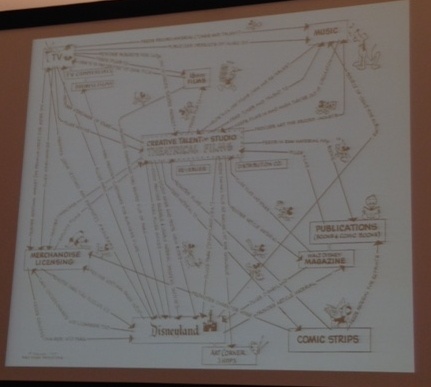 Wondering how to deal with the biggest inbound content challenges facing us? According to Steve Rubel, the solution is to Communicate in Constellations: Connect the Dots. See the Bigger Story.
Wondering how to deal with the biggest inbound content challenges facing us? According to Steve Rubel, the solution is to Communicate in Constellations: Connect the Dots. See the Bigger Story.
As he explains,
"One of the most critical issues facing marketers today is the sheer proliferation of content... [It} is only going to get harder to reach and connect with increasingly distracted audiences..."
In addition to content proliferation, there's content convergence, media fragmentation and increased personalization. The solution is another challenge. As Steve Rubel explains,
"Your challenge, my challenge is to communicate in constellations. We must deeply connect our paid, owned and earned programming into self-evident narratives. This way, our audiences won’t just see a star or two but the entire story. We have to link seemingly disparate stars in a digital sky of thousands by connecting the dots for them into a memorable tale."
Steve Rubel Details Content Challenges
Edelman's Steve Rubel researches digital marketing trends, and shares those internally and with clients as well as during conferences such as INBOUND15, when he presented Communicating in Constellations -- People – Platforms – Publishers. During this presentation, he focused on the major content challenges every marketer faces, detailed the associated subchallenges, while developing a way forward, and suggested tactical solutions.
Big Marketing Challenge: Content Convergence
To put the biggest inbound content challenge into perspective, think how much your world (and that of your prospects) now depends on a small, powerful, smart hand held device. Can you remember what life was like without it, not that long ago? And then think what you do on that smart device and which features you check first thing and consistently throughout the day.
Most people look at their phone and check social media first thing when they wake up. In fact, 60% of digital media consumption takes place on the smart phone. The average individual has 5 apps used on a regular basis. And, guess what? Google and Facebook control the majority of that mobile real estate (FB, What’s App, Instagram vs. YouTube), forming essentially a duopoly. The space is very crowded; you have more choices than ever before, but 2 companies control the content (Apple is 3rd controlling access to apps).
Subchallenge: Proliferation of options for content
Then, there's the unbelievable proliferation of content options - from images, videos, articles, updates, etc. on any number of social networks. In 2009, users uploaded 300 million pictures per month. It's now over 1 billion pictures per day! In other words, content is limitless and it's happening across a multitude of digital content platforms.
And, yet, time and attention are finite.
I'm sure you're experiencing this: more content to absorb, across multiple platforms, each trying to draw you in while you consume a snippet here, and another later elsewhere. The result particularly for brands is a fragmented narrative.
People don’t see the entire story as they used to. They no longer experience a beginning, middle and end. Instead, they see a snippet for example when Buzzfeed posts photos of news on Instagram without a background story. Even worse, that may not be the message you intended to have be snacked...
Subchallenge: Personalization as search learns from you
You are no longer anonymous online. Just as Amazon learns and adapts based on your purchase and search patterns, so do all the other digital search tools - from Google to the different social applications. Every day with every comment, share, reply, query and more, you are training the algorithm to better understand what you like/don’t like.
Rubel referred to Robert Scoble and his tips on how to train the Facebook algorithm.
The algorithm is responsible for what you see in your news feed or search results; it means that a lot of great stories may fail to reach you let alone an ideal audience. Think how Huffington Post puts out 1600 stories per day. No one reads them all; putting so many out means that some people may see some of those stories.
What this means is that algorithms are the new intermediary! As marketers, we need to embrace this! We need to understand what makes it through the content filters.
Inbound Content Solution: Embrace systems thinking. See things as connected.
How then to make sense of this big inbound content challenge? Well, it's not about content and content resources. Rather, it's about figuring out how to make it through the filtering algorithm.
Markets favor specialization. But, every specialist needs to be a great generalist to see how all the pieces connect together. In a networked world, you need networked systems thinking to see how the pieces fit together. (Check out the image below. Yes, it's fuzzy. You'll find a clearer version in the SlideShare below. It represents a brilliantly networked plan for Disneyland... Realize that this is pre-digital.)
If you see things as connected, you'll embrace a practical content approach based on people, platforms and publishers:
- People – know who trying to reach. What is their path for getting information? Based on income, geography, age, role… (Think personas - see Developing Personas for Content Marketing, How To Develop a Buyer Persona for Content Marketing and The Case for Personas in Business: Connecting With Customers.)
- More and more, people don’t go directly to media/brands sites. Rather, they will search or go to social sites. The pathway to people starts on platforms – which include search engines, social networks, as well as syndicators. BTW Twitter is way down the list. It shapes the zeitgeist, but it's not a driver of traffic to content sites. Pinterest is relevant for consumers, LinkedIn for business. Rubel considers Yelp to be search.
- Content goes from brands, media, influencers/publishers. It's a summer of love for publishers and platforms. Look at how Facebook partnered with media companies for Facebook instant articles. Big shift. Also look at the Snapchat discover partnership. Publishers include News Media/Digital Influencers/Brand Experiences.
You need to optimize accordingly.

Disney, example of Synergy + Synchronicity
Rubel referred to Disney as an example of synergy and synchronicity. Look at the Frozen content franchise (not to mention StarWars or Marvel). Great content should be pushed through every outlet possible in a connected way. Look for synergy between paid, earned, owned and synchronize the connections in the right sequence. "What is your Frozen?"
This is not a new idea as you can see from the Disney picture. Notice how everything is inter-connected. Integration is critical. You need to embrace Split-Style Storytelling where the news you read is different from what you say you read.
Every bit of content says something about what consumer is socially. People are doing this consciously and subconsciously. Content that gets shared elevates the identity of who does the sharing. News is currency. That means that you need to create content in two styles, one that is linear/logical and the other that is social by design and which creates an impulse is to share. For example, look at how the New York Times and BuzzFeed share the same story totally differently).
Here are a few examples - for specifics look at the presentation below:
- Look at the data – NewsWhip (Facebook latest driver of traffic to news sites) – and reverse engineer
- PWC conducted the 18th annual global ceo survey. It lives on their site in a linear/logical way. It has also been packaged up into interesting bits from which animated infographics have been created and sent to influencers. That's "social by design" from the get-go.
Rubel encourages a 2-Scaled Surface Area: move from making something awesome and then thinking about distribution to thinking about distribution as you make the content to speed up the experience and lower the data cost. For example,
- Amazon with distribution centers located close by Fedex for easy distribution
- Think about who has better distribution than you and align with that resource?
- Youtube, Vine, Instagram creators for PetCo to help distribute videos. Increasingly paid.
- Native advertising inside PSFK for Smirnoff + article with link to app?
Be thinking about implications of ad-blocking in operating systems. In that case, sponsored content may not be blocked, as well as Facebook or Instagram ads.
How does 1+1=3 in media? How to create string of things/dominoes. You need to plan that in advance. Examples:
- Conagra produced a bunch of recipes for Hebrew National: 32 ads, 1 for each NFL team. This generated a lot of visibility on Facebook. It then pitched the content to Mashable because other media read it; it drove social engagement. And then GMA saw the story and featured it.
Here is Steve Rubel's Communicating in Constellations -- People – Platforms – Publishers presentation from INBOUND 15:
Ultimately, success is not about putting more stars in sky - something that most inbound content marketers will be relieved to hear - but rather it's about being thoughtful and deliberate so you can put stars in the sky that can connect and make meaning. Focus on creating a great narrative in a connected fashion.
If you don't it won't be visible in this increasingly platformed world. Focus on seeing the big picture and how all of the parts interconnect - as Walt Disney did way back when.
Previous Steve Rubel Digital Trend Presentations
If you've not had the opportunity, definitely seek out Steve Rubel. His insights are invaluable. For additional perspective, you'll want to read these articles from a few of his previous digital marketing trend presentations:
- Steve Rubel On Digital Trends - BRITE 09
- BRITE Conference: Steve Rubel & 11 Digital Trends to Watch in 2011
- BRITE for Business Innovation at Columbia Business School: 3/5-6/12
What's your reaction? How are you dealing with the inbound content challenge? How might you implement Steve Rubel's inbound content solutions? Let me know in the comments.







